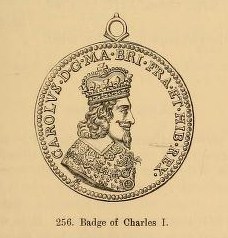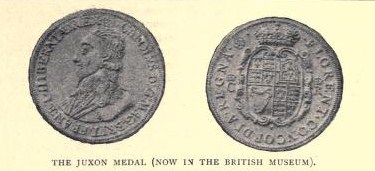Thomas Rawlins on:
[Wikipedia]
[Google]
[Amazon]
Thomas Rawlins (1620?–1670) was an English medallist and playwright.
 Rawlins's first dated medal is from 1641. Shortly afterwards, on the outbreak of the
Rawlins's first dated medal is from 1641. Shortly afterwards, on the outbreak of the  About 1648 Rawlins seems to have gone to France. He returned to England in 1652, and from that time till the Restoration earned a precarious livelihood, partly by making dies for tradesmen's tokens. He engraved the town-tokens of Bristol, Gloucester, and Oxford, and produced dies for London tradesmen in Broad Street, Hounsditch, St. Paul's Churchyard, and the Wardrobe. On 27 February 1657 he was in prison for debt at the "Hole in St. Martin's", and wrote for assistance to
About 1648 Rawlins seems to have gone to France. He returned to England in 1652, and from that time till the Restoration earned a precarious livelihood, partly by making dies for tradesmen's tokens. He engraved the town-tokens of Bristol, Gloucester, and Oxford, and produced dies for London tradesmen in Broad Street, Hounsditch, St. Paul's Churchyard, and the Wardrobe. On 27 February 1657 he was in prison for debt at the "Hole in St. Martin's", and wrote for assistance to
Ashmolean Museum, ''Highlights of the British Collection: The Oxford Crown''.British Museum, ''Cast silver gilt medal of King Charles I by Thomas Rawlins''.
;Attribution {{DEFAULTSORT:Rawlins, Thomas 1620 births 1670 deaths English medallists English engravers English dramatists and playwrights English male dramatists and playwrights
Life
Born about 1620, Rawlins appears to have received instruction as a goldsmith and gem engraver, and to have worked underNicholas Briot Nicholas Briot (about 1579 – 24 December 1646) was an innovative French coin engraver, medallist and mechanical engineer, who emigrated to England and became chief engraver to the Royal Mint in 1633 and is credited with the invention of the co ...
at the Royal Mint
The Royal Mint is the United Kingdom's oldest company and the official maker of British coins.
Operating under the legal name The Royal Mint Limited, it is a limited company that is wholly owned by HM Treasury, His Majesty's Treasury and is un ...
.
 Rawlins's first dated medal is from 1641. Shortly afterwards, on the outbreak of the
Rawlins's first dated medal is from 1641. Shortly afterwards, on the outbreak of the First English Civil War
The First English Civil War took place in England and Wales from 1642 to 1646, and forms part of the 1639 to 1653 Wars of the Three Kingdoms. They include the Bishops' Wars, the Irish Confederate Wars, the Second English Civil War, the Angl ...
, he went to the king's headquarters at Oxford. His signature appears on coins of the Oxford mint, 1644–1646, and in 1644 he produced the crown piece known as the "Oxford crown", from the view of Oxford introduced beneath the ordinary equestrian type of the obverse of the coin. In 1643 he prepared the badge given to the "Forlorn Hope", and received a warrant (1 June 1643) for making the special medal conferred on Sir Robert Welch. He struck at Oxford a medal commemorating the taking of Bristol
Bristol () is a City status in the United Kingdom, city, Ceremonial counties of England, ceremonial county and unitary authority in England. Situated on the River Avon, Bristol, River Avon, it is bordered by the ceremonial counties of Glouces ...
by Prince Rupert
Prince Rupert of the Rhine, Duke of Cumberland, (17 December 1619 (O.S.) / 27 December (N.S.) – 29 November 1682 (O.S.)) was an English army officer, admiral, scientist and colonial governor. He first came to prominence as a Royalist caval ...
's forces (1643), and until 1648 was employed in making medals and badges for the king's supporters. Rawlins also designed a pattern sovereign
''Sovereign'' is a title which can be applied to the highest leader in various categories. The word is borrowed from Old French , which is ultimately derived from the Latin , meaning 'above'.
The roles of a sovereign vary from monarch, ruler or ...
of Charles I, and the so-called "Juxon medal", probably the pattern for a five-broad piece. He was formally appointed chief engraver of the mint in the twenty-third year of Charles I (March 1647–March 1648).
 About 1648 Rawlins seems to have gone to France. He returned to England in 1652, and from that time till the Restoration earned a precarious livelihood, partly by making dies for tradesmen's tokens. He engraved the town-tokens of Bristol, Gloucester, and Oxford, and produced dies for London tradesmen in Broad Street, Hounsditch, St. Paul's Churchyard, and the Wardrobe. On 27 February 1657 he was in prison for debt at the "Hole in St. Martin's", and wrote for assistance to
About 1648 Rawlins seems to have gone to France. He returned to England in 1652, and from that time till the Restoration earned a precarious livelihood, partly by making dies for tradesmen's tokens. He engraved the town-tokens of Bristol, Gloucester, and Oxford, and produced dies for London tradesmen in Broad Street, Hounsditch, St. Paul's Churchyard, and the Wardrobe. On 27 February 1657 he was in prison for debt at the "Hole in St. Martin's", and wrote for assistance to John Evelyn
John Evelyn (31 October 162027 February 1706) was an English writer, landowner, gardener, courtier and minor government official, who is now best known as a diarist. He was a founding Fellow of the Royal Society.
John Evelyn's diary, or m ...
, whom he had met in Paris.
At the Restoration of 1660 Rawlins was reinstated as chief engraver at the mint, Thomas Simon
Thomas Simon (c. 16231665), English medalist, was born, according to George Vertue, in Yorkshire about 1623.
Simon studied engraving under Nicholas Briot, and about 1635 received a post in connection with the Royal Mint. In 1645 he was appoi ...
being then styled "Chief Engraver of Arms and Seals". He had a residence in the mint, and in June 1660 was ordered to engrave the king's effigies for the coins. From 30 July to 24 September 1660 he was engaged in engraving a privy seal for Ireland and five judicial seals for the Welsh counties.
Rawlins died in 1670. He was married to Dorothea Narbona. In Richard Flecknoe
Richard Flecknoe (c. 1600 – 1678) was an English dramatist, poet and musician. He is remembered for being made the butt of satires by Andrew Marvell in 1681 and by John Dryden in '' Mac Flecknoe'' in 1682.
Life
Little is known of Flecknoe's li ...
's ''Miscellanies'' there is a poem on Rawlins.
Medals
The following is a list of his principal medals: * ''William Wade'', 1641. * ''Declaration of Parliament'', 1642. * ''Peace or War'', rev. Sword and olive-branch; ''Forlorn Hope'' badge; ''Sir Robert Welch''; ''Bristol taken''; ''Meeting of Charles I and Henrietta Maria at Kineton'', 1643. * ''Sir William Parkhurst''; ''Badges of Charles I and Henrietta Maria'', 1644. * ''Sir Robert Heath'', 1645. * ''Thomas Harper of Alveton Lodge, Staffordshire'', 1647. * ''Sir Robert Bolles'', 1655. * ''Coronation Medal'', rev. Charles II as a Shepherd ("Dixi custodiam"), 1661. * ''Dominion of the Sea'', rev. ''Nos penes imperium'', 1665. He also executed badges with portraits of the royal family, and the medals ''Death of Charles I'', (1) rev. Hammer striking diamond on anvil, 1648; (2) rev. Rock buffeted by Winds; and (3) rev. Salamander amid flames, 1648.Works
In 1640, Rawlins published ''The Rebellion'', a tragedy that, according to the title-page, was acted nine days together and subsequently by the king's company of revels. The scene is laid in Seville, and a prominent part is taken in the play by the tailors of the city. It was dedicated by Rawlins to his kinsman Robert Ducie of Aston, Staffordshire. Two comedies, both printed after the year of his death, are usually assigned to Rawlins: * '' Tom Essence, or the Modish Life'' (sometimes attributed toEdward Ravenscroft
Edward Ravenscroft (c. 1654–1707) was an English dramatist who belonged to an ancient Flintshire family. He was entered at the Middle Temple, but devoted his attention mainly to literature.
Ravenscroft was the first critic to posit that Sh ...
, a play in debt to Molière
Jean-Baptiste Poquelin (, ; 15 January 1622 (baptised) – 17 February 1673), known by his stage name Molière (, , ), was a French playwright, actor, and poet, widely regarded as one of the greatest writers in the French language and world ...
's ''Cocu Imaginaire Cocu may refer to:
* Cocu, Argeș, a commune in Argeș County, Romania
*'' Le Cocu magnifique'', a Belgian play by Fernand Crommelynck
*Phillip Cocu
Phillip John-William Cocu (born 29 October 1970) is a Dutch professional football manager and for ...
''; it was licensed for performance at Dorset Garden on 4 November 1676, and printed in 1677.
* '' Tunbridge Wells, or a Day's Courtship'', a comedy, printed in 1678.
A collection of poems called ''Calanthe'' (with ''Good Friday, being Meditations on that Day'', 1648) is signed "T. R.", and William Oldys
William Oldys (14 July 1696 – 15 April 1761) was an English antiquarian and bibliographer.
Life
He was probably born in London, the illegitimate son of Dr William Oldys (1636–1708), chancellor of Lincoln diocese. His father had held the ...
identified the author with Rawlins. Complimentary verses by Rawlins are prefixed to ''Messallina'', a tragedy, by his friend Nathanael Richards, and to Richard Lovelace's ''Lucasta''.
Notes
External links
Ashmolean Museum, ''Highlights of the British Collection: The Oxford Crown''.
;Attribution {{DEFAULTSORT:Rawlins, Thomas 1620 births 1670 deaths English medallists English engravers English dramatists and playwrights English male dramatists and playwrights